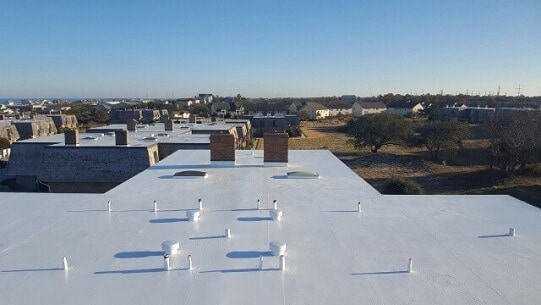- April 18, 2018
- Posted by: bmroofing
- Categories: News, North Carolina, Tips

Did you know that most commercial roofs should be inspected at least twice a year? If your area has been subject to high winds, tornadoes, hail storms, or hurricanes, you would be wise to schedule an inspection immediately! Regular roofing maintenance and inspections have been proven to increase roof longevity significantly.
When Should You Inspect Your Roof?
Ideally, commercial roofs should be inspected both before and after severe weather seasons. Spring and fall are the ideal times to inspect your commercial roof.
B&M Roofing Maintenance Checklist
Here is what we look for when inspecting a commercial roof:
Exterior Roofing Inspection:
Roof Top: We will go over every inch of your roof to look for leaks or the possibility of leaks. If the area recently encountered storms, we will look for storm damage. It is important to identify these as quickly as possible. The field membrane is the material laid flat horizontally on the roof. It makes up the majority of commercial roof systems. Some things we look for are ponding water, bubbled or lifted material, loose seams or faded membranes. The sooner it is taken care of, the less damage to your property.
Drains and Gutters: Roof drainage is one of the most important factors. The rain water needs to be directed away from the roof and away from the building. A good drainage system will keep your building free of standing water and potential leaks.
Commercial Roofing Inspection
Storm Debris and Animal Damage: With a storm comes a lot of debris and build-up of leaves and twigs. These should be cleared away before any damage can be fixed. Rodents and birds can also make nests on your roof, around heating or air conditioning vents, causing damage.
Interior Roofing Inspection: Having completed the exterior inspection we would then closely examine and evaluate the roof’s interior system. We look for signs of rust or water stains, structural defects, noticeable corrosion or weaknesses, and the type and condition of mechanical fasteners that come from the roof deck. Known roofing leaks should also be examined inside of the building for determination of the leak source or presence of any issues such as roof splits.
Perimeter Inspection: The perimeter details are made up of the edges of your commercial roof system. When installed new, they are generally metal, such as a metal gravel stop or metal cap. Older buildings will have stone blocks or clay caps. If we find cracks, dents, splits or completely missing perimeter details, there is a problem.
Remember, a commercial roof inspection will not only help determine if there are any leaks or damage to your property, but it will also identify any potential problems before they happen.


Hello ,
I saw your tweets and thought I will check your website. Have to say it looks very good!
Great article and it was helpful to the details you shared, great tips are shared to this site. Thank you for sharing this wonderful thoughts!
That was a nice information, thank you for sharing. It’s a pleasure to visit here.